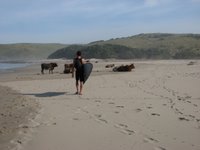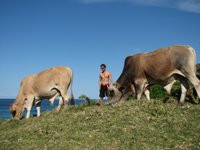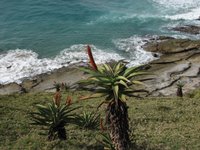The Transkei



The real South Africa Starts when you cross the Great Kei River and enter an area known as the Transkei, home of the Xhosa people and birthplace of Nelson Mandela. All of a sudden you leave the developed "white" south africa and the change is immediate. The landscape is marked by beautiful rolling hills covered with the burning read flowers of the Eastern Cape Aloe.
As you continue north the countryside starts to become covered with small round houses known as rondevals. This thatched roof dwellings are the traditional home of the Xhosa people.
The coast is fairly mountainous, reminding me of Big Sur with large headlands and rolling hills. The coastline is basically undeveloped earning it the nickname of the Wild Coast. Most roads in the Transkei are dirt roads of various quality. The local Xhosa people live in small round thatched houses known as rondevals. The mud brick
walls are painted turqoise blue using paint from a naturally occuring clay. They basically look like little smurf houses dotting the hillsides. The Xhosa are pastoralists and rely on their animals and small gardens for subsistance. Cows, sheep, goats, donkeys, and horses roam freely everywhere, manicuring every square centimeter of the hillsides like lawnmowers. Driving the dirt roads one must constantly be prepared for packs of goats and sheep blocking your path.
Coffee Bay
Coffee Bay is a funky little place in the Heart of the coastal Transkei. There are two "backpackers" where travelers from all around the world come to stay. They cater to young folks looking for fun adventure-like things to do during the day.
The place that we stayed at was called the Coffee Shack and was run by Dave (previous South African surf champ) and his wife Belinda. Adam and I would try to get up early most days and search for surf.

Our days were spent at a remote point break called Lwandili. I had surfed this amazing place 3 years earlier and I was excited to return to this magical spot. Although Lwandili was located about 15 Kilometers from Coffee Bay as the crow flies, it took us one hour and 40 Kilometers of rough driving to reach the beach. We would park our car near several amazing vacation homes and walk a mile up the beach to the point. On the walk we would pass by herds of happy beach cows and young local kids with their Transkei toys ( Small cars made of bailing wire and pieces of shoes for wheels). On the point there was a small cave where we would set up camp for the day.
point. On the walk we would pass by herds of happy beach cows and young local kids with their Transkei toys ( Small cars made of bailing wire and pieces of shoes for wheels). On the point there was a small cave where we would set up camp for the day.



One glorious day, with the sun warming the cool winter's morning, we arrived at Lwandilli to a new swell. The waves were not perfect but sizeable. We suited up quickly and Eric (our new friend from Maui) and I jumped off the point into the surging surf while Adam stayed back to film. As we made our way out to the top of the point, a pod of at least 200 dolphins (no exageration) swam to join Eric and I. They were everywhere, under me around me, jumping out of the water. 
It was clear they came to play. They were waiting for me to catch a wave so they could surf with me. My heart was racing and I struggled to get a wave before they lost interest and decided to leave me. Due to the sardine run the shark risk is quite high, but I felt like they were there to ptotect us.
Finally I caught a wave and they were everywhere...on the wave riding the energy all around me, as facinated with me as I was with them. As I paddled back out I decided to dive under water, I could hear them talking and squeaking, so many little voices like an underwater ampitheatre.
The fun lasted for about a half an hour and the dolphins decided to depart, it was time to find the sardines and feast on the ocean's bounty.
The next day we arrived to find one of the beach cows dying on the beach near the point. It was clear the cow was on its last few breaths. After catching on of my final waves to the beach, I saw that the cow was now dead, and the rest of the heard had departed. Suddenly a group of Xhosa men came down from the hill with a large machete and other butchery tools. 

They quickly went to work skinning the animal right before me. I ran up the point to grab my camera and capture the moment. When I returned there was a group of about 15 people. Some women had gathered a stack of palmfronds and layed them beside the cow. The men continued to hack up the cow piece by piece, and hand it to two young boys who would wrap it and carry it away to a group of women in the distance. The sand around the cow was soaked with blood which trickled out into the surf making the whitewater turn pink. The smell of death was in the air and we could smell it all the way back to our car. A cow had died, but a village now had food for a week or more. Life and death in the Transkei.
The men continued to hack up the cow piece by piece, and hand it to two young boys who would wrap it and carry it away to a group of women in the distance. The sand around the cow was soaked with blood which trickled out into the surf making the whitewater turn pink. The smell of death was in the air and we could smell it all the way back to our car. A cow had died, but a village now had food for a week or more. Life and death in the Transkei.
Upon returning to our car we found that are back window had been broken. Nothing was stolen since we left the car empty. We were not very upset since we knew the risk was there. Whoever broke in surley did so out of need or despiration.
After a week of good surf and a few big nights drinking and celebrating it was time to head out. Back to East London to fix our window and take care of business. South Africa was very good to us but I was ready for something new and unknown. It is hard to believe we will be in Madagascar in a few days. The adventure continues.


















